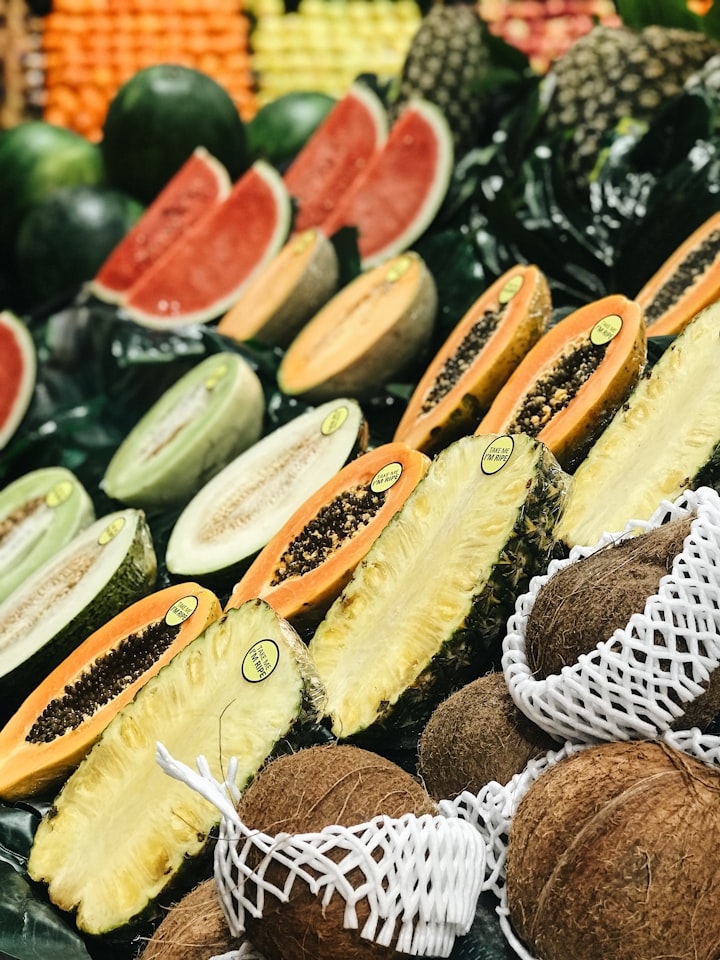
FOOD
Any material taken to give nutritional support for an organism is referred to as food. Food is usually made up of carbohydrates, lipids, proteins, vitamins, and minerals and is derived from plants, animals, or fungi. To give energy, preserve life, or encourage growth, an organism consumes a material that is assimilated by the organism's cells. Different animal species have different feeding behaviors to meet the needs of their individual metabolisms, which have often evolved to fill a specific ecological niche in specific geographical situations.
Omnivorous people are extremely flexible, having adapted to find food in a variety of habitats. Humans have traditionally obtained food through two methods: hunting and gathering and cultivation. Humans settled into agriculture lifestyles with diets modified by the agriculture options in their location as agricultural technologies improved. Geographic and cultural diversity have resulted in the development of a vast range of products, herbs, spices, methods, and meals, as well as a variety of cuisines and culinary arts. Ingredients have become more widely available beyond their geographic and cultural origins as civilizations have combined through influences like international trade and globalization, resulting in a cosmopolitan exchange of varied cuisine traditions and practices.
The industrial food industry, which produces food through intensive agriculture and distributes it through complicated food processing and distribution systems, now provides the majority of the food energy required by the world's ever-increasing population. Because conventional agriculture is primarily reliant on fossil fuels, the food and agricultural sector is one of the most significant contributors to climate change, accounting for up to 37% of global greenhouse gas emissions.In the global response to climate change, reducing the carbon intensity of the food system and reducing food waste are critical mitigation approaches.
Sustainability, biological diversity, economics, population expansion, water supply, and food access are just a few of the social and political concerns that the food system has an impact on. The "right to an acceptable standard of life, including appropriate food," as well as the "basic right to be free from hunger," are human rights recognized by the International Covenant on Economic, Social, and Cultural Rights (ICESCR). Food security is frequently a priority international policy action as a result of these fundamental rights; for example, the Sustainable Development Goal 2 "Zero Hunger" aims to eliminate hunger by 2030.
Food safety and security are monitored by international organizations such as the International Association for Food Protection, the World Resources Institute, the World Food Program, the Food and Agriculture Organization, and the International Food Information Council, and are frequently regulated at the national level by agencies such as the US Food and Drug Administration.
Food Definition and Classification
Any material taken to give nutritional support for an organism is referred to as food. It is ingested orally by animals for growth, health, or enjoyment and can be raw, processed, or prepared. Water, fats, proteins, and carbs make up the majority of food. Food also contains minerals (such as salts) and organic compounds (such as vitamins). Photosynthesis is used by plants, algae, and some microbes to produce their own food molecules. Water is present in many cuisines and has been classified as a food in its own right. The organism receives energy and nutrients from food. Water and fiber have low energy densities (calories), but fat has the highest energy density. Some inorganic elements are also required for the proper functioning of plants and animals.
Human food can be classed in a variety of ways, depending on its content or how it is produced. The number and make-up of dietary groups might differ. Vegetables and Fruit, Cereals and Bread, Dairy, and Meat are the four main classes that characterize their origin and nutritional role in most systems. Whole grains/cereals, refined grains/cereals, vegetables, fruits, nuts, legumes, eggs, dairy products, fish, red meat, processed meat, and sugar-sweetened beverages are common categories in diet quality studies.
Cereals, roots, pulses, and nuts, milk, eggs, fish and shellfish, meat, insects, vegetables, fruits, fats and oils, sweets and sugars, spices and condiments, beverages, foods for nutritional purposes, food additives, composite dishes, and savory snacks are among the nineteen food classifications used by the Food and Agriculture Organization and the World Health Organization.
Food Sources
Food forms a web of interlocking chains in a given ecosystem, with primary producers at the bottom and apex predators at the top. Detrovores (which eat detritus) and de composers are two more web features (that break down dead organisms). Algae, plants, bacteria, and protests are primary producers who get their energy from sunshine. The herbivores that eat the pants are primary
consumers, and the carnivores who eat those herbivores are secondary consumers. The diets of some organisms, such as most mammals and birds, include both animals and plants, and they are classified as omnivores. The apex predators, or creatures with no known predators in their habitat, are at the end of the hierarchy. Humans are frequently referred to as apex predators.
Vegetables, fruits, cooked meat, milk, eggs, mushrooms, and seaweed are all sources of nutrition for humans. Cereal grain is a staple food that produces more food energy than any other crop on the planet. 87 percent of all grain output is made up of corn (maize), wheat, and rice. Just over half of the world's crops (55%) are grown for human consumption, with 36% for animal feed and 9% for bio fuels. In the production of fermented foods such as bread, wine, cheese, and yogurt, fungi and bacteria are used.
Types of Sources
Sunlight
For practically all life on Earth, photosynthesis is the ultimate source of energy and nourishment. Plants, algae, and some microorganisms use it as their primary source of nutrition. All organisms that rely on these organisms further up the food chain, from coral to lions, would be unable to thrive without it. Sunlight is received and used to convert water and carbon dioxide in the air and soil to oxygen and glucose. The glucose is subsequently stored as an energy reserve and the oxygen is released.
Plants
Around 2,000 plant species are farmed for food, and many plants and plant parts are eaten as food. There are multiple varieties of many of these plant species.
Plant seeds are a good source of nourishment for animals, including humans, because they contain the nutrients required for the plant's initial growth, as well as numerous beneficial fats like omega fats.
In reality, seed-based foods account for the majority of human food consumption. Cereals (corn, wheat, rice, etc. ), legumes (beans, peas, lentils, etc. ), and nuts are all edible seeds. Sunflower, flax-seed, rapeseed (including canola oil), sesame, and other oil-seeds are commonly processed to generate rich oils.
Seeds are abundant in unsaturated fats and are considered a healthy food when consumed in moderation. Not all seeds, however, are suitable for human consumption. High seeds, such as those found in lemons, can cause choking, while seeds from cherries and apples contain cyanide, which can be dangerous only in large quantities. Seeds are another food source for birds (for more information, see birdseed).
Plants' ripened ovaries, including the seeds therein, are called fruits. Because animals that eat the fruits may excrete the seeds some distance away, many plants and animals have co-evolved to the point where the fruits of the former constitute an appealing food source for the latter. Fruit-eating animals are known as frugivores. Primates, who are largely frugivorous, are one example of a co-evolutionary connection. As a result, fruits are an important part of most societies' diets. Tomatoes, pumpkins, and eggplants are examples of botanical fruits that are consumed as vegetables.
Vegetables are a form of plant materials that is frequently consumed as food. Root vegetables (potatoes and carrots), bulbs (onions), leaf vegetables (spinach and lettuce), stem vegetables (bamboo shoots and asparagus), and inflorescence vegetables are all examples (globe artichokes and broccoli and other vegetables such as cabbage or cauliflower).
Animals
Animals are either directly or indirectly used as food via the items they produce. Meat is an example of a direct product derived from the muscle systems or organs of an animal. Animal-produced foods include milk from mammary glands, which is sipped or processed into dairy products in many cultures (cheese, butter, etc.). Bees create honey, a reduced nectar from flowers that is a favorite sweetener in many cultures, and birds and other animals lay eggs, which are often consumed. Blood is consumed by some cultures as a thickener for sauces, as a thickener for sauces, or in a cured, salted form for times of food scarcity, and blood is used in stews such as jugged hare.
For cultural, culinary, health, ethical, or ideological reasons, several cultures and people do not consume meat or animal food products. Vegetarians prefer to avoid animal-based foods to varied degrees. Vegans do not eat or consume any foods derived from or containing components derived from animals.
Perception of flavor
Sweet, sour, salty, bitter, and umami are the five various sorts of tastes that animals, specifically humans, have. The flavors that supply the greatest energy (sugar and fats) are the most fun to eat as animals have developed, while others, such as bitter, are not. While water is necessary for survival, it has no flavor. Fats, on the other hand, particularly saturated fats, are thicker and richer, making them more pleasurable to consume.
Sweet
Sweetness is nearly always induced by simple sugars like glucose or fructose, or disaccharides like sucrose, a molecule that combines glucose and fructose. Because complex carbohydrates are made up of lengthy chains, they lack a sweet flavor. Artificial sweeteners like sucralose are used to replicate the sugar molecule and provide a sweet taste without the calories. Raw sugar, which is unprocessed and has an amber color, is one of the other forms of sugar. Sugar has a pleasant flavor since it is necessary for energy and survival.
The stevia plant has a chemical called steviol, which has 300 times the sweetness of sugar when extracted while having little effect on blood sugar.
Sour
The taste of acids, such as vinegar in alcoholic beverages, causes sourness. Citrus fruits, such as lemons, limes, and to a lesser extent oranges, are examples of sour meals. Sour is important in evolutionary terms because it indicates a food that has gone rancid due to germs. However, many foods are mildly acidic, which helps to stimulate taste buds and increase flavor.
Salty
The taste of alkali metal ions like sodium and potassium is saltiness. Although eating pure salt is considered to be exceedingly unpleasant, it is used in practically every dish in small to moderate amounts to enhance flavor. Sea salt, fleur de sel, kosher salt, mined salt, and grey salt are among the various forms of salt available, each with a different level of saltiness.
Its relevance lies in the fact that the body requires and maintains a delicate electrolyte balance, which is the kidney's job. Salt can be iodized, which means it has had iodine added to it, which is a vital nutrient for thyroid function. As a way of preserving the food for longer, several canned goods, particularly soups and bottled broths, tend to be rich in salt. Because salt stimulates water excretion, it has historically been employed as a meat preservative. Dried foods, on the other hand, contribute to food safety.
Bitter
Bitterness is an unpleasant experience that is characterized by a harsh, pungent flavor. Bitter food s. include unsweetened dark chocolate, caffeine, lemon rind, and some fruits.
Umami
Savoriness, or umami (/ummi/ from Japanese pronunciation: [mami]), is one of the five basic tastes. It's been described as savory, and it's found in broths and cooked meats.
Umami is tasted through taste receptors that respond to glutamates and nucleotides, both of which are abundant in animal broths and fermented foods. Monosodium glutamate (MSG) is used to add glutamates to foods, and inosine monophosphate (IMP) or guanosine monophosphate (GMP) is used to add nucleotides to foods (GMP). Scientists now regard umami to be an unique flavor because it has its own receptors rather than developing from a combination of previously established taste receptors.
Meats, shellfish, fish (including fish sauce and preserved fish like Maldive fish, sardines, and anchovies), tomatoes, mushrooms, hydrolyzed vegetable protein, meat extract, yeast extract, cheeses, and soy sauce all have a strong umami flavor.
food-related issues
Food availability, quality, and production issues affect every area of human life because of their relevance to human life.
Problems with nutrition and diet
There are a variety of diseases that can be induced or treated by dietary changes, ranging from perfect health to death from starvation or malnutrition. Dietary deficiencies, excesses, and imbalances can have a severe impact on health, leading to conditions such as scurvy, obesity, or osteoporosis, diabetes, cardiovascular disease, as well as psychological and behavioral issues. The study of nutrition tries to figure out how and why certain dietary factors affect one's health.
Food nutrients are divided into numerous groups. Fat, protein, and carbs are the macro-nutrients. Minerals and vitamins are micro-nutrients. Water and dietary fiber are also present in food.
As previously said, natural selection has built the body to prefer sweet and fattening meals for evolutionary diets, which are good for hunters and gatherers. As a result, sweet and fatty foods are uncommon in nature yet ex tremely enjoyable to consume. Enjoyable foods are readily available to people in modern times, thanks to advances in technology. Obesity is a result of this, which affects both adults and children.
Hunger and Starvation
Malnutrition and, eventually, famine result from a lack of food. This is frequently associated with famine, which occurs when entire communities go without food. This has the potential to have a catastrophic and widespread impact on human health and mortality. Rationing is a method of distributing food in times of scarcity, most notably during wartime.
Hunger is a major concern on a global scale. Around 815 million people are malnourished, and over 16,000 children die each day as a result of hunger-related conditions. Famine scales are used to evaluate food deprivation, which is classified as a deficiency need in Mas-low's hierarchy of requirements.
Food Waste
Food loss and waste are defined as food that is not consumed. Food waste or loss can occur at any point in the food supply chain, including during manufacturing, processing, distribution, retail and food service sales, and consumption. Approximately one-third of the world's food is wasted. The United Nations Environment Programme determined that food waste was a problem in all nations at all levels of economic development in a metanalysis published in 2021 that excluded food lost during production. According to the study, global food waste totaled 931 million tonnes (about 121 kg per capita) from three sources: 61% from households, 26% from food service, and 13% from retail.
Agriculture's impact on climate change (3.3 billion tons of CO2 emissions annually) and other environmental challenges is largely due to food loss and waste. Furthermore, improperly treated or reclaimed food waste, such as by composting, can have a variety of detrimental environmental impacts. Landfill gas produced by anaerobic digestion of organic matter, for example, is a major source of the greenhouse gas methane, and unreclaimed phosphorus in food waste leads to more phosphate mining. Furthermore, by reducing the total quantity of water, land, and other resources required in agriculture, reducing food waste in all stages of the food system is a significant aspect of reducing the environmental effect of agriculture.
Target 12.3 of the United Nations' Sustainable Development Goals aims to "halve global per capita food waste at the retail and consumer levels by 2030, as well as reduce food losses along production and supply chains, including post-harvest losses." Food waste reduction is a big part of climate change mitigation methods.
About the Creator
Prakuzo
I Write Health and Fitness, Personal Growth and Spirituality






Comments
There are no comments for this story
Be the first to respond and start the conversation.